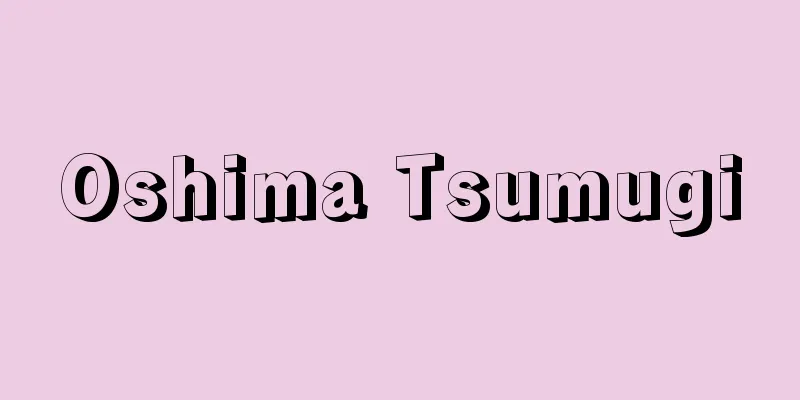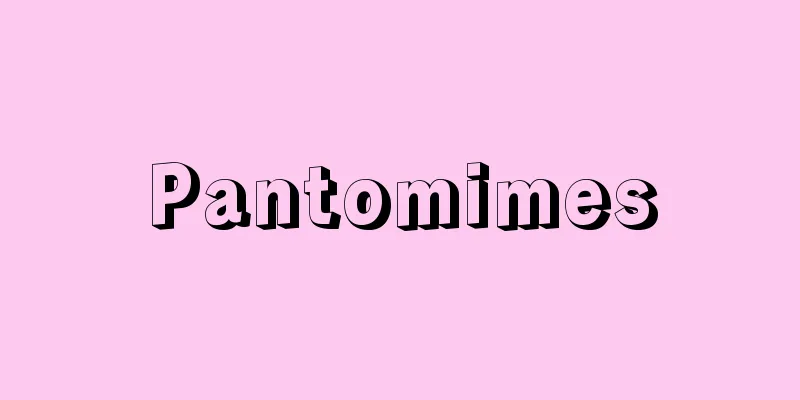Oshima Tsumugi

|
It is a plain-woven silk fabric produced mainly in the Naze area of Amami City on Amami Oshima Island in Kagoshima Prefecture, and is a high-quality kimono fabric with a kasuri pattern. It can also refer to other silk fabrics produced using the same techniques and called "Oshima" in various regions. It is not clear when Oshima Tsumugi was first produced, but it probably became popular around the beginning of the Edo period when the technique was introduced from Kumejima Tsumugi in the south, and in 1720 (5th year of the Kyoho era) the Shimazu Domain issued an order restricting the wearing of Tsumugi, so it must have become widespread by that time. During the domain era, it was only produced in small quantities as a tribute item, but it began to flourish around the Meiji period. However, today, most of it is produced in mainland Kagoshima, which is convenient for transportation, and many of the fabrics are woven by people who moved from Amami to Kagoshima, and these are also called Oshima Tsumugi. Before the Second World War, Kagoshima woven fabrics were called Kagoshima Oshima, with weft kasuri patterns. Each production association distinguishes between the production areas, but they are all Oshima Tsumugi. Korean-made fabrics are also now imported to some areas. Oshima Tsumugi used pongee threads in the early Meiji period, but the warp threads were changed to raw silk, the weft threads to pongee threads, and then the warp and weft threads were changed to dupioni silk threads. Currently, it is woven with loosely twisted silk threads. The original name "tsumugi" has simply been retained. The dyeing of the kasuri threads was done by hand-tying the threads, but nowadays, a more efficient weaving machine that ties the threads like a mat is used. The unique Mud Oshima dyeing method involves dyeing the fabric with a boiled liquid made from finely chopped teichiki (also called Sharinbai) bark, and then soaking the fabric in mud to produce the unique black-brown color. This is the so-called mud dyeing method, which uses iron mordant containing tannins from the iron in the mud. There is also Doroai Oshima, Indigo Oshima, and Color Oshima made with chemical dyes. The patterns were originally simple geometric ikat designs, but after the Meiji period they changed to intricate cross-shaped ikat designs. Intricate patterns are woven using detailed ikat techniques, and the unique Oshima ikat patterns are said to have been inspired by the scales of a poisonous snake (Habu). Although imitations such as Murayama Oshima and Isesaki Oshima were created, the status of "genuine Oshima" remains unshakable, and its unique, subdued colors and patterns are widely used for kimono fabrics for men and women, and are loved as town wear and everyday clothing. [Kadoyama Yukihiro] Mud-dyed cloth. The top one is the Tatsugo pattern © Amami Oshima Tsumugi Cooperative Association "> Oshima Tsumugi The fabric is dipped in iron-rich mud to bring out the dark brown color that is characteristic of Oshima Tsumugi. © Kagoshima Prefecture Tourism Federation . Mud dyeing of Oshima Tsumugi Source: Shogakukan Encyclopedia Nipponica About Encyclopedia Nipponica Information | Legend |
|
鹿児島県奄美(あまみ)大島の奄美市名瀬(なぜ)地区を中心に生産される平織の絹織物で、絣柄(かすりがら)を主とした高級着尺地。また、これに技法を同じくして生産され、「……大島」の名でよんでいる各地の絹織物を含んでさすことがある。大島紬がいつごろから生産されていたかは明らかではないが、おそらく南の久米島(くめじま)紬から技法が伝わる江戸初期ごろから盛んになり、やがて1720年(享保5)には島津藩から紬着用の制限令が出されているので、このころには一般に普及していたのであろう。藩政時代には貢納品として少量生産されたにすぎないが、明治ごろから隆盛に向かった。しかし現在では交通運輸に便利な鹿児島本土産のものが生産量も多いのが現状で、奄美から鹿児島へ移った人たちによって織られているものが多く、これも大島紬とよんでいる。第二次世界大戦前鹿児島で織られていたものは、緯(よこ)絣でこれを鹿児島大島とよんだ。それぞれの生産組合は生産地を区別しているが、いずれも大島紬には変わりはない。なお、韓国産のものも現在では一部に輸入されている。 大島紬は、もと紬糸を使用したが、明治以後には、経(たて)糸に生糸、緯糸に紬糸を、ついで経緯とも玉糸に変わり、現在では甘撚(あまよ)りの絹糸で織るようになっている。紬というもとの名称が、そのまま残されているにすぎないのである。絣糸の防染は、手括(てくび)りによる括絣によったが、現在では能率的な「むしろ」のように縛る織締機(おりしめばた)を使っている。染色は、独特の泥大島ではテーチキ(シャリンバイともいう)の樹皮を細かく刻んだものの煮出し液で染め、さらに泥土中につけ独特の黒褐色の色調を出す。いわゆる泥土中の鉄分によるタンニン含有物の鉄媒染法(いわゆる泥染め)である。このほか泥藍(どろあい)大島、藍大島や、化学染料による色大島もある。模様はもと簡単な幾何文の絣柄であったが、明治以後には細かい十字絣による絣柄へと転換する。そして精緻(せいち)な柄行を細かい絣技法により織り出すが、その大島絣独特の柄ゆきは、毒蛇(ハブ)のうろこ模様の表現にあったといわれる。 これをまねた村山大島とか伊勢崎(いせさき)大島などとよばれるものが生まれたが、「本場大島」の地位は揺るがず、独特の色の渋さと模様は、広く男女和服地として使われ、町着、普段着として愛用されている。 [角山幸洋] 泥染めの反物。一番上は龍郷柄©本場奄美大島紬協同組合"> 大島紬 鉄分を含有した泥土につけ、大島紬の特色である黒褐色の色調を出す©公益社団法人鹿児島県観光連盟"> 大島紬の泥染め作業 出典 小学館 日本大百科全書(ニッポニカ)日本大百科全書(ニッポニカ)について 情報 | 凡例 |
Recommend
Oilless bearings - Oilless bearings
…There are plastic bearings that require lubricat...
Cremation grave - Kasobo
A tomb where the deceased is cremated and the rema...
Viola da braccio (English spelling) violadabraccio
…Two types of bowed string instruments coexisted ...
Energy flow - Energy flow
In an ecosystem, various substances are exchanged ...
Silver crown - Ginkanmuri
...There are Gin Yagura, Kin Yagura (Figure 10), ...
Albertazzi, Adolfo
Born: September 8, 1865 in Bologna [Died] May 10, ...
Branchiostegidae
…A general term for the Japanese white tilefish, ...
Ta Meht (English spelling)
The city is located at the outlet of a tributary ...
Early childhood education
Early childhood education can be understood as ear...
Tatsuno Kingo
Year of death: March 25, 1919 Year of birth: Augus...
Novalis - Novalis (English spelling)
A poet representing the German Romantic movement....
Baden-Baden (English spelling)
A city in the state of Baden-Württemberg in southw...
Scepter
A ceremonial item used in the attire of the nobil...
Naval base - Gunko (English spelling)
A port is a base for naval operations, a port fro...
Investment counsel
A profession that involves building assets throug...






![Isshiki [town] - Isshiki](/upload/images/67cae83d73bd2.webp)


